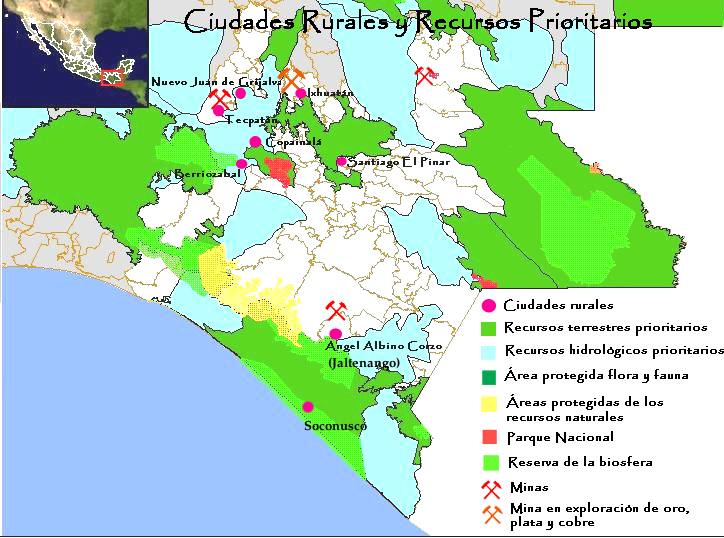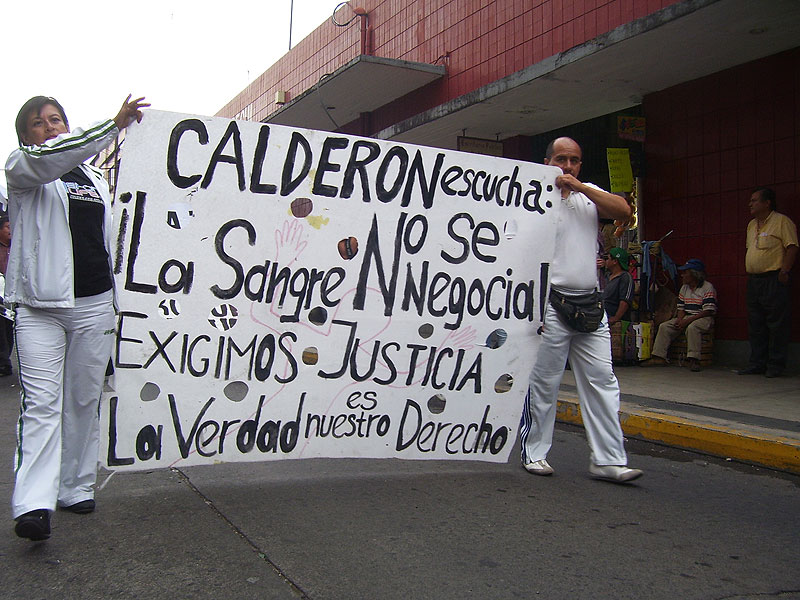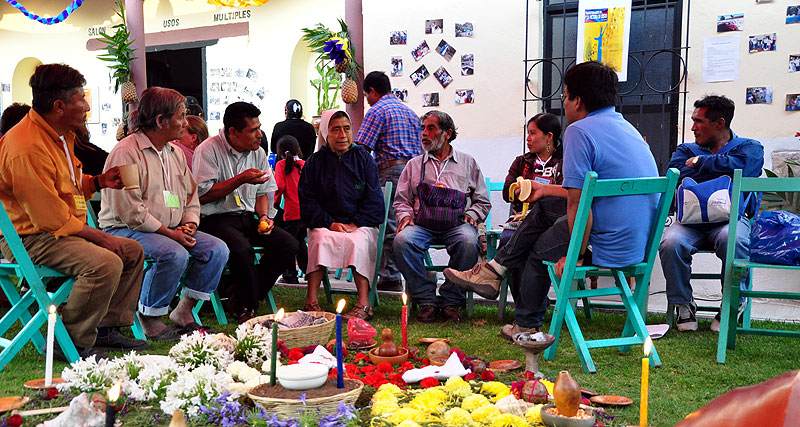PRESENCE OF TRANSNATIONAL CORPORATIONS
31/03/2012ANALYSIS : Mexico – Elections and fear that history may be repeated
28/08/2012In May 2012, the member-organizations of the Peace Network in Chiapas and the Collective for Kollective Analysis and Investigation (CAIK) published a report summarizing a Civil Mission of Observation in the Sustainable Rural Cities (CRS) Program that took place in October 2011. This article highlights several parts of this report. According to the government, the CRS Program has as its central objective “To concentrate the dispersed population that resides in small marginalized communities into a nucleus that does not disrupt their lives, respects their identity, and strengthens their citizenship.” Regardless, the Civil Mission was able to prove that this objective has not been fulfilled and it argues that instead the Program “has violated and continues to violate the right to self-determination of the peoples and communities and has resettled them by displacing them from their territory.” Furthermore, it stresses that other interests are part of the efforts to displace the people from their communities under the pretext that this is the only way of improving their access to basic services and of rescuing those who live in “risk zones.”
Rural cities as “response to poverty”
The Chiapas state government sees the principal cause of poverty as being the dispersion of populations in a state that without a doubt occupies second place in level of marginalization at the national level, preceded by Guerrero and followed by Oaxaca (National Institute on Statistics and Geography, INEGI 2010). According to the argument of the government, that rural communities find themselves far from populated centers makes complicated their access to basic services like electricity, potable water, education, and health. As a response, during the six-year term of the present state government, the CRS Program has been developed. Instead of providing services to people in their own communities, these peoples are moved toward existing services and concentrated in rural cities. In the majority of the observed cases, affected peoples have neither been consulted nor informed in a correct, complete, and anticipated fashion regarding these radical changes in their lifestyles.
Millennium Development Goals in the Chiapas state Constitution
The CRS Program can be included within the Millennium Development Goals (MDGs) that were established by the United Nations in 2000. The MDGs prioritize combating extreme poverty. Despite the fact that there are challenges regarding the MDGs—the most important one being that the necessities of different peoples across the globe cannot be standardized—the Chiapas state Congress included the MDGs in its Constitution in July 2009. In the case of Chiapas, it has been observed that for the same reason a distortion was generated in seeking better specific rates without addressing the structural character of poverty (for example, the case of maternal mortality, as has been illustrated by researcher Graciela Freyermuth).
Sustainable Rural Cities in Chiapas
Presently there exist 7 CRSs in different stages of planning, construction, or inhabitation in Chiapas. The two rural cities that already have people residing in them are Santiago el Pinar and Nuevo Juan del Grijalva. In September 2009, Felipe Calderón, President of the Republic, inaugurated the “first sustainable rural city in the world”: Nuevo Juan del Grijalva1. Santiago el Pinar, the second rural city located in the Highlands of Chiapas, was also inaugurated by Calderón in April 2011. Two other rural cities are currently being constructed, named Ixhuatán and Jaltenango, together with two sustainable rural villas: Jitotól and Emiliano Zapata. Another CRS in the planning stages—Soconusco—will be located on the Coast. There exists contradictory information regarding the possibility of building a CRS in Copainalá, although the first stone has already been set.
Human-rights violations committed by the CRS Program
The report made by the Observation Mission affirms that several human rights are violated by the CRS Program, with the consequence of generally violating the right to self-determination. Several testimonies suggest that, during the planning stages of relocation, state officials employed both promises and threats to remove all the support communities had if they chose not to accept resettlement. This pressure has caused many people finally to accede to being transferred to rural cities, given that they come to see it as their only choice.
This transfer implies a radical change in the lives of those it affects, debilitating the food sovereignty that in one way or another the majority of people could enjoy in their communities of origin: “In the cities we must buy everything,” summarized someone interviewed by the Observation Mission. For his part, the UN Special Rapporteur on the Right to Food observed after visiting Santiago el Pinar and Nuevo Juan de Grijalva in June 2011 that the CRS Program does not improve access to food for its residents. He also called for “an independent and comprehensive evaluation of the experiences of Nuevo Juan de Grijalva and Santiago el Pinar before the establishment of new settlements following the same model.”2
In the different stages of the Program’s development, those directly affected were not consulted as to how it was that they would like to live in their new communities. In terms of types of homes, for example, residents of Nuevo Juan del Grijalva reported that “They didn’t ask for anyone’s opinion; experts from Mexico City came, and they were the ones who planned it all.” In the end, residents have been granted fairly small plots of land, and homes are 36 square meters in size (and also often made up of prebuilt materials that do not resist rain well) for families that are at times large. Former residents of the Sayula community who were then displaced to Nuevo Juan del Grijalva stressed that “the government told us that it would give us a larger and more comfortable house, but these are rats’ nests.” On another hand, in their communities, they were accustomed to cooking with firewood, but in the CRS homes they do not have separated kitchens, such that to cook with firewood would be dangerous.
Regarding the right to land, the rural cities generally are located many hours of travel from communities of origin. Due to lack of labor options, though, men often travel to their former lands, staying there for a week or two so as not to spend too much on transport. This situation also leads to family breakdown. In some cases, the move to the rural city has implied the loss of titles to land. The residents of Nuevo Juan del Grijalva, for example, were promised compensation for losing their lands following landslides in 2007. However, they never received this money, and in fact some were incarcerated for having protested this situation. Some of these lands were expropriated by the Federal Electricity Commission (CFE), which then started to work the lands, possibly to build a new dam.3
The violation of the right to work is related to the right to land, given that campesinos/as are accustomed to living in this way. In their new surroundings they do not have the chance to continue working in this manner. A central part of the CRS Program, according to its own objectives, is to provide employment to its residents. Regardless, the options that exist do not generate enough income to sustain families, nor are there sufficient jobs for everyone. The chicken farm and the greenhouse for flowers in Santiago el Pinar, or the dairy plant in Nuevo Juan del Grijalva, do not generate enough money, such that people come to see it as necessary to return to their lands to continue sowing crops or seeking other options outside the CRS. As a resident of Nuevo Juan del Grijalva notes, “the government promised us much work, employment, and all that. But what has happened is that until now we have not had work.”
The supposed beneficiaries have made criticisms of even the central aspects of the program: access to services. Several commentators for example noted that the proximity of a hospital did not guarantee the quality of the services provided. In an article in the weekly Mirada Sur (5 March 2012), a picture was painted of the situation in Santiago el Pinar that is perhaps even more distressing than that which was seen during the Observation Mission’s visit. It notes that in that time, of the more than 2000 residents of the CRS, only 10 families were actually residing there. In an interview, Domingo Gómez Gómez, a municipal official for Santiago El Pinar, reported that the water-treatment plant was not functioning, and so there was no water. Due to the debts owed to the Federal Electricity Commission (more than 1.6 million pesos), there was no electricity. For this reason, the hospital could not operate 24 hours a day, nor was there potable water.
Economic and political interests behind the CRS Program
According to the member-organizations of the Civil Mission, behind the official objectives for social and economic development of marginalized populations, one finds economic interests of national and international firms and political interests of the governments that are also being served through the dislodging of the present residents from their lands.
Mining and electrical energy

© CIEPAC, A.C.
The growing number of concessions granted to Canadian, U.S., and British mining companies in Mexican territory is relevant to the context of the CRS Program. In the last 2 six-year terms an estimated 28,000 concessions have been awarded in Mexico with hundred-year terms. A December 2008 report by the Center for Economic and Political Investigation for Communal Action (CIEPAC) stressed that “from the view of the government and the firms, the Rural Cities can ‘solve’ the question of what to do with thousands of families that will be forcibly displaced from their lands to give way for mineral extraction and the dams that would be built to satisfy the needs of mining corporations.” For example, in the case of Ixhuatán, the area of mining interests is the same as that of the construction of the rural city. The residents of Nueva Esperanza who will be displaced to Ixhuatán commented in detail to the Civil Mission regarding the work that the mines carry out and how these operations deal with the ejido so that it allows them to work freely: “They entered, began to drill and blast; when they were blasting, they gave us 200,000 for the ejido […]. They are foreigners, from Canada.” The displacement of the population could give a free pass to the Cangold Limited mining firm that also could use it for cheap labor.
Beyond this, the Federal Electricity Commission announced in July 2010 its plans to build a new hydroelectric dam on the Grijalva River, called Copainalá Dam or Chicoasén II. To compensate the communities that would have to be moved, there are plans to install clinics and schools. In the case of Nuevo Juan del Grijalva, peoples were resettled in the rural city after a 2007 landslide. Nonetheless, there exist strong suspicions4 that the landslide was not caused by rains but was instead provoked by dynamite. Shortly after the landslide, the CFE built two tunnels in the zone to generate electricity, according to the words of residents.
Productive reconversion and cultivation of agro fuels
The project Reducing Emissions from Deforestation and Environmental Degradation REDD Plus (REDD+) is related to the CRS Program, given that residents are encouraged toward a productive reconversion that forces them to abandon the production of their own food. For example, in the case of the planned CRS in Copainalá, governor Juan Sabines requested that agricultural producers switch to alternative crops such as that of pine varieties that are used to produce biodiesel. In the Acapetahua municipality, where the rural city of the Soconusco region will be built, the greatest concentration of the production of African palm in the state is located. This crop also serves as an agro fuel. Regarding these questions, the Las Abejas Civil Society noted in September 2010 that the government “now does not want us to have our milpas and cultivate other ancestral foodstuffs, but rather to sow African palm and agro fuel pine. With the milpa and beans we feed ourselves. Palms and pine trees produce agro combustibles to feed cars.”5
The ‘ecological‘ interests of the plans for state and federal development imply that the communities residing within biological reserves be resettled, or that they not use these lands for agricultural activities. Communities in the El Triunfo biosphere, for example, see it as necessary to resettle in the Jaltenango CRS because the Chiapas state government has entered the carbon-trade market, using this ecological reserve.
Counterinsurgency
Journalist Hermann Bellinghausen notes that the “creation of these urban ‘poles’ is promoted by large-scale firms in the consumer universe: Televisión Azteca, its banking and retail trade firm and Elektra, Telcel, Coppel, a chain of ‘convenience’ stores, and the largest consortiums for paint and cement.6“ He affirms furthermore that the CRS Program “serves a function in systematic counterinsurgency, given that it is developed in indigenous communities of southeastern Mexico to disrupt their lives and expel them from their territories.” During the forum “Exclusion… neoliberal inclusion” organized by research and university centers in May, Marcos Arana, investigator for the Salvador Zubirán National Institute for Medical and Nutritional Studies, compared the project with the strategic hamlets established in Vietnam in 1962 toward the end of dismantling communities and their links to the land and collectivity. In the case of Santiago el Pinar, the location presumably responds also to political interests. In 1999, the government created this municipality to arrest the growing presence of the Zapatista Army of National Liberation (EZLN) in the area. The CRS is located in this same municipality, close to the Zapatista caracol of Oventic as well as the autonomous municipalities of San Andrés Sakamch’en de los Pobres and San Juan de la Libertad.
Mobilizations against “death projects” and looting
@ SIPAZ
As has been previously mentioned, the CRS Program from the beginning has been strongly criticized by organized civil society. On 19 November 2010, for example, more than a thousand Catholics from 11 municipalities of the Chiapas Highlands carried out a pilgrimage in San Cristóbal de Las Casas to manifest their opposition to mineral exploitation and the construction of dams and rural cities, all projects they consider to be “death projects.”
Beyond this, following the Regional Forum for the Defense of Human Rights carried out in San Cristóbal de Las Casas in December 2011, participants pronounced themselves in opposition to “the continuation of policies of construction of rural cities, because these affect the traditional forms of production and modes of life of the local population; beyond this, the new cities do not provide better access to services, as had been promised.” They indicate that this policy of resettlement that is promoted with the rural cities “is a veiled form of forced displacement that favors economic interests that are foreign to the communities”
Furthermore, nearly two years ago, in August 2010, in a communiqué released by the San Pedro Chenalhó parish, believers associated with this community expressed their rejection of the possible construction of a rural city in their municipality. In the communiqué they clarified that “We are concerned that the rural cities project will be imposed and not be consulted with the people, whether they are in agreement or not […]. This leads us to the conclusion of definitively rejecting the construction of rural cities, because it is clear that this plan is made so that we abandon our lands, thus allowing transnational firms to occupy them. Once our populations are concentrated, they can control us better, forcing us to cultivate other crops that will not be those of the milpa, beans, and so on.”
… … …
- Inauguró el Presidente de la República la Ciudad Rural Sustentable Nuevo Juan del Grijalva (Return…)
- Declaración final de la misión, Naciones Unidas Alto Comisionado para los Derechos Humanos (Return…)
- De la tierra al asfalto, Informe de la Misión Civil de Observación de la Red por la Paz Chiapas y CAIK al Programa de Ciudades Rurales Sustentables, 2012 (Return...)
- These suspicions are based on the testimony of peoples in the area obtained during the Observation Mission as well as in a study carried out by the Mexican League for Human Rights (LIMEDDH). (Return…)
- Chiapas: opening of new Sustainable Rural City in Los Altos (Return…)
- Adiós a la tierra, La Jornada Suplemento Ojarasca (Return…)


